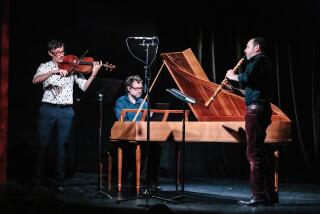He stands, and sits, to conquer
The world’s two most charismatic, most beloved cellists are, without question, Mstislav Rostropovich and Yo-Yo Ma. And there is little chance that Anssi Karttunen could ever challenge their popularity, given that his specialty is difficult new music. But for a growing number of cognoscenti, this spectacular Finnish cellist has no equal, and it was heartening that his guest appearance with the Los Angeles Philharmonic New Music Group sold out a Green Umbrella concert at Zipper Hall on Tuesday night.
Karttunen wasn’t, to be honest, the only attraction; the program ended with Esa-Pekka Salonen conducting the West Coast premiere of “Mania,” the dazzling chamber cello concerto he wrote for his longtime friend and colleague in 2000. But it was mainly Karttunen’s night. He conducted, as well as played. His third hat was as arranger; he led the first performance of his version for eight cellos of a piano etude by Magnus Lindberg.
In all, it was a night to dive deep into the sound of the cello, a sound Karttunen called, in a preconcert discussion, so beautiful you never want it to end. Preceding “Mania,” there was cello and nothing but, with five relatively short works for ensembles of six, seven and eight cellos.
The opener was Pierre Boulez’s “Messagequisse” (Message Sketch), a score from 1976 for solo cello against an ensemble of six cellos. Dedicated to Paul Sacher, it is a quick series of bracing coded messages to the late Swiss philanthropist, using the letters (translated into musical pitches) of his last name as the basic material. The music has a breathless, fleeting quality, always in dizzying motion but, hummingbird-like, seeming still and just out of grasp. It leaves behind a long, lingering impression. Salonen conducted as if born to the style, making one wonder why he conducts so little of Boulez’s music these days.
Putting down his bow, Karttunen conducted Hans Werner Henze’s “Trauer-Ode fur Margaret Geddes,” Luciano Berio’s “Korot,” and Karttunen’s own arrangement for eight cellos of a piano etude by Magnus Lindberg. The Henze, a funeral ode in memory of a German princess, is thickly scored for six cellos, almost decadent in its bittersweet harmonies and Bach-haunted. The Lindberg etude is fantastical, flamboyant music, at times sounding as lavish as the richest Richard Strauss in this cello-intensive arrangement. Berio’s piece (korot means beam in an ancient language, but Karttunen forgot which one), also for eight cellos, buzzes ethereally and beautifully. Karttunen conducted everything by dutifully beating time, but he knows what cellos can do and managed to inspire gorgeous playing from the Philharmonic’s cello section.
There was one cello piece too many, the world premiere of Denis Cohen’s “Eleista” for six cellos and electronics; Salonen conducted and Karttunen did not appear in it. The title is Finnish for gestures, and the French composer takes the gesture of unified repeated notes, breaks them apart and puts them back together. At 13 minutes, it was the longest of the cello pieces, and the least imaginative.
It was also quickly forgotten, once “Mania” began. This is one of Salonen’s most attractive scores, with a burbling 14-piece ensemble conveying a series of changing landscapes. Against this, Karttunen plays wonderfully rhapsodic melodies and exciting bravura passages, and he does so with cool abandon, impossibly contradictory as that may sound. The piece lasts about 18 minutes and doesn’t, for a second, linger, although it is seldom quite as manic as the title suggests.
Salonen has said that Sibelius was an influence and there are nods to Ravel and Debussy in the colorful orchestration and to Stravinsky in the frantic closing pages. But the stronger impression is Salonen’s own personality in music that is clever and entertaining on the surface but also complex in a deeply intriguing and satisfying way. The performance was full of joy.
More to Read
The biggest entertainment stories
Get our big stories about Hollywood, film, television, music, arts, culture and more right in your inbox as soon as they publish.
You may occasionally receive promotional content from the Los Angeles Times.











